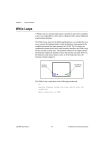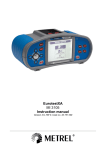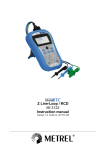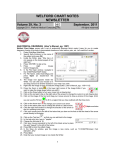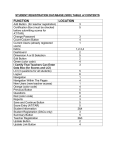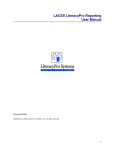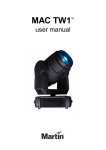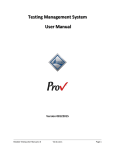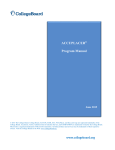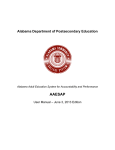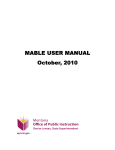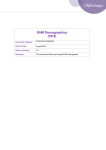Download Guidance for Computerized Student Recording Keeping System
Transcript
Section 13. Guidance for Data Collection and Computerized Student Record Keeping 13.1 Overview The U.S. Department of Education requires each state to have a computerized individual-student record-keeping system. This system is known as the Management Information System (MIS). It is the data collection system used to collect all of the required data elements for the National Reporting System (NRS). The data system used by the Wyoming Adult Basic Education programs at the state and local level is LACES by LiteracyPro System, Inc. NRS Guidelines state: “The data used for NRS are only useful if they are valid (i.e., measure what they are supposed to measure) and reliable (i.e., collected in the same way by different people and at different locations). To obtain valid and reliable data, data collectors at the State and local levels must understand the measures and follow the proper procedures for collecting the measures at all times with all people. States are responsible for promoting data quality and implementing training and quality control procedures for NRS measures.” Section 13 will outline Wyoming’s implementation of the above requirement. Each program director, teacher and data-entry person should be familiar with the requirements for data quality control and reporting. Selected portions of the NRS Implementation Guidelines may be found in the appendices to this section, and the entire document at www.nrsweb.org/docs/ImplementationGuidelines.doc. 13.2 Data Collection All programs are required to collect demographic and performance data on each participant. 13.2.1 Data system setup Each year you will create staff, student and class set-ups in the LACES management information system. Schedules, locations and dates should be included. 13.2.2 Orientation, student intake and enrollment Student data should be collected as the student enters the program. Every student must attend orientation, take pretests on TABE 9/10 or BEST tests, establish goal(s), and attend one hour of instruction before they are considered enrolled and entered into the LACES system. The purpose of orientation is an exchange of information between the student and the program. This exchange of information ensures the student knows what to expect from the program and what the program expects from the student. This exchange of information directs the program in the services offered to the student. Each orientation will be designed to meet the needs of the students. This means that each program serves unique populations in their area and the 1 needs of these populations must be taken into consideration as the orientation is designed. There are several components that should be customized and included in every orientation: • • • • • • Program information GED information Commitment and motivation to learn Assessment Learning styles Goal setting Other types of information that may be included are: • • • • • • Local employment office information Study skills Test taking skills Computer skills Time management Additional training opportunities Collaborative partners may join your orientation session to share information on complimentary programs offered at your location or other local sites. Employment Specialists from the local Workforce Center or post-secondary institutions can be invited to participate to make students aware of the opportunities available to them after they obtain the GED. Students attending to brush up on basic academic skills should have a clear understanding of and inclusion in the educational process. Program information should include information on the location and times of all classes so, as a student’s schedule changes, the student has options in choosing another location or time. Information about how to progress through the academic program should be presented to the student. Explaining to the student the assessment process and the results of these tests is recommended. GED information is important to many ABE/GED students. The majority of our students enroll with the purpose of obtaining the GED. They will be interested in the process of registering for the test, where they will take it, the cost of the test and general information about the test itself. Motivation and commitment refer to students that begin classes and, at the first barrier or challenge, they disappear, never staying long enough to see achievement or to feel that they are making progress. Each student needs to take a critical look at where they are, what barriers they face in returning to school, and if those barriers can be overcome. Delaying the start date until the student can focus on being successful in school is a mature decision on the part of the student. Some programs have used a weekly calendar to help students look at their current commitments and identify times they may have available for classes. 2 Accurate assessment is critical to educational level placement and curriculum design for students. The TABE or BEST tests (BEST Plus or BEST Literacy) are used as assessment tools to allow the student to see what areas need the most attention. The level is identified and the student begins to work. Accurate assessment is critical to setting realistic goals. Learning styles come with many theories and definitions. There is no universal learning styles inventory. Every expert has his own theory. The bottom line is that students may have strong auditory skills, visual skills, spatial skills or kinesthetic skills, and they use these strengths to sort through information and learn. Learning styles focus on students’ strengths, not on their weaknesses. One learning style does not indicate greater intelligence than another style. Some learning styles are better suited to traditional classroom techniques. A key to reaching students is to use strategies and techniques that fit the needs of the students. Suggestions to incorporate the concepts behind learning styles include: • Build on strengths rather than repeating weaknesses. • Teach new concepts by relating them to practical applications. • Be creative and attempt to vary your teaching style. • Use multi-sensory strategies to present material. Many learners must see, say, hear and touch before they can develop full mental images that stick and make sense. • Vary lessons, re-teaching and reviewing in a variety of ways. • Respect different learning styles. • Change an activity when it is not working. • Encourage the use of learning aids and tools (e.g. calculators, highlighter pens, extra worksheets, computerized learning programs, tape recorders, videos, demonstrations, maps, charts, experiences and rulers). • Talk with learners about their learning process. Ask them what does and does not work for them. Realistic goal setting with a regular review of the goals has been linked to student retention. As you know, the longer you can keep a student in class, the greater the chance of the student’s success in passing the GED or meeting their goals. The goal is to have students remain long enough in the program to develop the necessary skills to be successful outside the classroom. Intake forms are set up to match the required data needed to set up a student file in LACES (see sample in appendix). The student signature on the intake form is the permission we use to aggregate the data into the 3 state data-collection system known as LACES. Each assessment in the folder should match the assessment screen indicating the form and level of the test used. Scale scores and a grade level should be entered. Goal setting sheets should show both short-term and long-term goals. NRS goals are determined by the information the student has given on the goal sheets. Additional information may include release-of-information forms the student has signed, disability information and copies of any documents showing eligibility for Adult Education services. Video online training for specific applications is available on the LACES system. 13.2.3 Student pre-test assessment Students must be assessed with a valid form of one of the required instruments. Standard testing conditions and timing of the tests are essential to accurate results. Programs must ensure that the versions of the test alternate between pre-test and post-test. LACES is designed to prevent inappropriate entries such as out-of-range test scores. Professional judgment must always be used in placement within EFL levels. In order to establish the initial benchmark to measure growth, students are to be pre-tested during the enrollment process and prior to full course instruction. 13.2.4 Class attendance Attendance for each student must be tracked for each class. This information is entered into the data system and allows the agency to evaluate class participation and appropriateness of class scheduling and staff performance. Hours may be totaled and entered weekly or monthly (by the 5th of the following month). Non-instructional hours may be tracked by entering them without linking them to a class. All instructional hours must be linked to a class for them to be counted on the National Reporting System tables. Attendance must be taken using either sign-in and sign-out sheets or electronic time-clocks which have students sign in and out. 13.2.5 Goal attainment and post-test performance Specific, Measurable, Attainable, Realistic and Timely (SMART) goals must be established for each student. As students attain their personal goals, those accomplishments should be noted under the entry for the goal. If the goals are educational in nature, they will ensure the student’s completion. Goals beyond the GED, such as employment and postsecondary or skills training are the true motivators for our students. The post-tests should be administered after 60 hours of instruction. In cases where students have high attendance hours such as institutional settings or intense ESL classes, testing should be completed after the first 90 to 120 hours or at the end of a managed enrollment session of more than 60 4 hours. Post-testing will demonstrate the educational gains that are part of your program’s performance. Exception: For ASE students who complete a full enrollment period but have not accumulated the required 60 hours of instruction, a teacher may request a waiver and at the director’s discretion, test after 50 hours of instruction. The appropriateness of this exemption must be verified in writing by the program director and monitored by the state office on a regular basis. At no time may any program have more than (20%- which will be reduced in subsequent years) of their students tested before 60 hours. 13.2.6 Student records Your student files are the permanent records of your students’ efforts and successes. You must maintain the student files for three years after the end of the multi-year contract or extensions. Information from the LACES system may be copied and put into the permanent record. Test results, assessments, sample work, intake forms and other pertinent information should be kept in the student’s file. Only students attending 12 or more hours are considered retained and will count in our NRS tables. 13.2.7 Submission of the data electronically Data on each student is entered electronically each month for the state data collection staff’s review. Keep attendance, testing information and goal attainment information up-to-date. The text files on LACES are dynamic and in real-time, which makes it available to the state where the data is used to create aggregated data reports, local program report cards, and comparative reviews. Students are exited by LACES after 90 days with no attendance recorded which will automatically begin the schedule for follow-up on employment goals. If a student leaves and comes back in the same year, they may be reactivated in the system. 13.2.8 Using LACES reports for program evaluation and improvement LACES is designed to provide performance and service level data reports that can be used for evaluation at the state or program level. Reports can be created and used by teachers to assist them in managing student files, tracking test needs and goal attainment. Programs can monitor classes and make informed decisions concerning scheduling, curriculum, supplemental service needs and continuous program improvement. 13.2.9 Standardized forms The ABE Program requires each local program to use the standard intake form for public sites. This is checked during the annual site review. 13.2.10 On-going professional development There are two forms of professional development planned each year. The first includes face-to-face trainings on different aspects of the NRS 5 requirements, researched-based instructional strategies to teachers, and local directors’ trainings. Second are online trainings offered three times each year on the data system. These are given in small group sessions of eight to twelve participants. In the fall, LACES staff gives training on updates to the system, introduction to data entry and an open question and answer session. The winter training is on reports and queries, new issues, and any anticipated changes in the system. In the spring, training on end-ofthe-year procedures for closing files, data checks and diagnostics, and how to begin the next year’s classes is conducted. 13.2.11 Wyoming data quality checklist In alternate years, local program contractors must complete the WY Data Quality Checklist, which is tailored after the federal Data Quality Checklist. This gives additional information on any professional development needs for data staff or director. This also ensures that local program contractors understand the data quality and collection system. 13.3 Computerized Student Record Keeping 13.3.1 Meeting the federal standards The LACES system has complete documentation on how it meets the federal standards. This is found online when you sign into LACES on the USER page. This page is divided into two sections: Online Help and Development Update. 6 Figure 1. LACES “USER” page The User News page, illustrated in Figure 1, contains the following: Online Documentation Answer your questions quickly by Clicking here (or Online Documentation above) to open the Table of Contents, including links to: User Manual that is Searchable and Printable NRS Tip Sheet for LACES Troubleshooting Tips Reporting systems Selection of Video Demonstrations Development Update Build1092_State_ABE_README.pdf shows how changes affect your data. Build 1092 At-a-Glance: ABE Posted 6/15/2009 Assessments 7 The detail page at the All Assessments tab is now read only GED retest scores now calculating the total score correctly Changing the date of an assessment changes the FY automatically A “Move Forward” button has been added to the student assessments screen CASAS Life and Work Listening Assessment added CASAS Power Form 306 assessment added Reading added to the TABE Locator test BEST 2008 Literacy assessment now correctly generating EFLs and populating Table 4 Assessments for students who change in mid-year from ESL to non-ESL Students/Hours Must now save changes in the student demographics screen before clicking link to employment status The Last Hour Date field updates when an hours record is deleted FY records corrected for students entering at Completed Advanced ESL or other invalid entry level FY records corrected for students completing a level and advancing to the next level FY records corrected to accurately display number of instructional hours Goals Users cannot enter a goal with status set to No Value Entered Searches Fixed Assessment Status Search Student FY Based Diagnostic Searches 13.3.2 NRS and LACES For specific information on the NRS and how LACES works, look in the online Documentation section (Figure 2). 8 Figure 2. LACES Documentation links screen 13.3.3 Functions for analyzing data Each program must be able to analyze and report on the collected data as subpopulations (e.g. age, ethnicity or gender). Specific sorting and search features have been built into LACES to accomplish these types of reports. You may sort the list of student names in LACES in a variety of ways, including by gender and ethnicity (Figure 3). Under the FIND tab you may search your student list by AGE. These features allow deeper data mining and allow the state and local programs to use this information when considering program management and improvement. Analyzing the students we serve is important for professional development, scheduling, and to truly understand the needs of our students and community. 9 Figure 3. LACES search/sort screen example Analysis of students who enrolled but did not stay long enough to count for NRS (“unfundables”) is another valuable tool for local programs (Figure 4). Information about who is not staying may help illuminate program weaknesses, the demographics of the subgroup, and whether changes are needed to serve these adults. 10 Figure 4. “Unfundables” screen 13.3.4 Identifying student goals Identifying students by goal for follow-up surveys is very important for documenting performance. The core goals for which you can search are Employment, Postsecondary, and Obtain a GED. A full list of possible goals to search is illustrated in Figure 5. Obtain GED Obtain secondary school diploma Place in postsecondary education Place in training program Complete educational functioning level Achieve work-based project learning goal Achieve citizenship skills Vote or register to vote 11 Increased involvement in community activities Enter employment Retain employment Leave public assistance Increased involvement in child's education Help child more with school Increased contact w/child's teacher More involvement in child's school activities Increased involvement in child's literacy activities Read to children Visit library (with/for child) Purchase books or magazines Figure 5. Example of goal choices The search in LACES allows you to search the current year as well as previous years. This search is located in the FIND tab under “Achievements & Goals.” This screen (Figure 6) will appear. 12 Figure 6. Achievements and Goals screen 13.3.5 Conducting edit checks Mining Data is used to gather information that will guide local programs in setting goals for program management and improvement. The assessment policy, goal-setting procedures and follow-up guidance included in this Policy Manual are the foundation to ensure processes are working to produce accurate and reliable data. Edit checks are to confirm test scores, identify missing data and highlight other data-integrity problems within the LACES system. There are two diagnostic searches listed under FIND. They are the Student Data-based Diagnostic Searches (Figure 7) and the Fiscal Year-based Diagnostic Searches (Figure 8). 13 Figure 7. Student-based Diagnostic Search screen Figure 8. Fiscal Year-based Diagnostic Search screen 14 Selecting the year and then clicking each item will bring up records of students who may need to have their personal information, assessments and goals revisited when a possible error is indicated. Training on reports and queries is offered in January or February each year. The technical support staff at LACES is available during normal working hours to assist you with system functions as you check for errors. Matching internal data in LACES with external student data files must be conducted by state staff during site reviews and by local staff on a local schedule to confirm that the student file is accurately reflected in the LACES system. 13.3.6 Policy and procedure manual Each local program must develop a policy and procedure manual based on a table of contents established by the state. The local program receives policies and guidelines and must clearly define procedures for implementing these policies and guidelines. This will be part of the site review. Having established procedures for orientation, entering data by the fifth of each month, establishing a file review schedule, and local training on assessments helps the program be consistent and organized with regard to their data and better able to manage their program. 13.3.7 Data reporting timelines A. Monthly Data Entry Each month, baseline data on entering students, demographic information, goals and assessments is entered. Updates and post-testing information is also entered on a monthly basis. Data is dynamic and must be immediately accessible to both local and state staff. Accurate data entry is vital and is used to determine educational gains, goal attainment and employment activity. Local programs should mail or e-mail news items regarding local ABE activities, marketing information and class schedules to keep the state office informed of ongoing changes in programs. B. Quarterly Narrative Reports A Quarterly Narrative Report (see sample in Appendix) must be sent to the State Office in the fall (by October 15), winter (by January 15) and spring (by April 15). In these reports: • • Local program contractors should make sure their statistical data is accurate and sent in on time. Information reported should be helpful in managing the program. The number of students enrolling each quarter is reported, allowing identification of trends which may help with staffing and marketing efforts. 15 • Information on successes and challenges encountered by the program should be described. This information is also helpful in writing the narrative for the end-of-the-year report. The last section records the follow-up survey numbers for employment, post-secondary education and skill training. GED attainment is recorded as the students successfully complete each subtest. The follow-up lists created for employment surveys should be kept to support this activity. Data match will be used to confirm data from surveys when possible. C. Semi-annual Reports Local program contractors should summarize their progress in attaining the program improvement goals written and submitted with their application or reapplication each year. Modifications to the goals are permitted only at mid-year and must be submitted to the State Office. D. Two End-of-the-year Reports A written narrative answering a set of questions issued by the State Office must be submitted. These questions are to be sent out in the fourth quarter each year. The second required report is the Annual Fiscal Report, which describes the contract amount and expenditures for the contract year. 13.3.8 Analyzing data Each local program should analyze their program data by asking the following questions: • • • • • • • Does the proportion of students served in ABE, ASE and ESL appear reasonable for the local service area? Do the student demographics raise any issues regarding lack of service to subpopulations of age, gender or ethnicity? Does local performance on NRS Table 4 indicate adequate performance compared to the negotiated performance levels the state issues each year? Does the local program have a history of meeting performance goals and, if not, is this addressed in program improvement goals? Does the local program obtain adequate pre- and post-test rates? Does the local program offer sufficient intensity and duration of instruction to produce learning gains? Is goal setting for employment and post-secondary education reflecting how students are transitioning to jobs and technical institutes, colleges or universities? Programs will establish continuous program improvement goals from the data and above analysis. 16
















